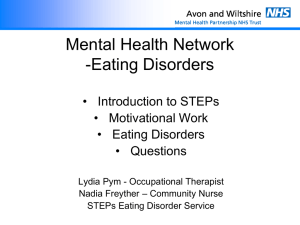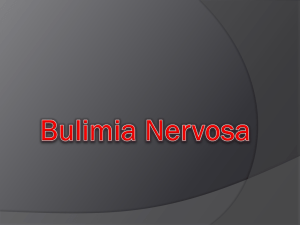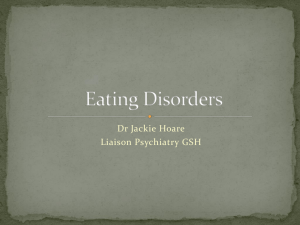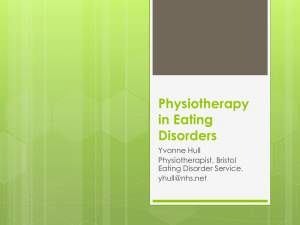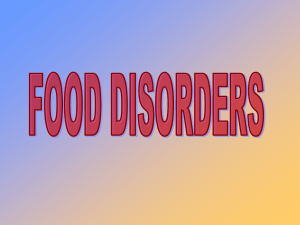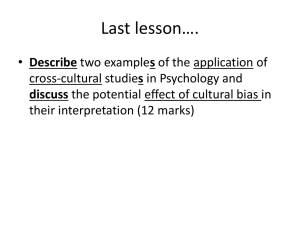Eating disorders & their effects
advertisement
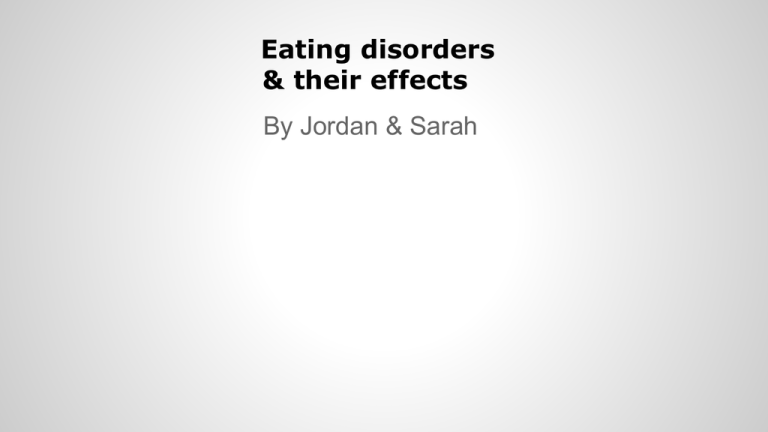
Eating disorders & their effects By Jordan & Sarah Bulimia Nervosa-causes and effects There are two different categories of Bulimia, depending on your symptoms, you are either a purging or a non-purging bulimia. Often times both of these two methods can become interlapped with one another. The purging bulimic will ● binge eat, ● misuse laxatives, ● self induce vomiting ● use enemas or other forms of expulsion of food and fluids. The nonpurging bulimic will ● undereat ● binge eat, fast ● strict dieting as well as over excessively exercise Some signs and symptoms of either type of Bulimia Nervosa include. Being preoccupied and concerned about your body and weight throughout the day. Being unable to control your eating habits, under eating or overeating constantly (binge eating consistently). (Mayo Clinic diseases and conditions, by Mayo Clinic staff,created Apr. 03, 2012) Bulimia Nervosa causes and effects-continued ● Cause the exact cause of Bulimia Nervosa are unknown, but they are thought to be a combination of emotions, self perception, societal impact and biological traits. They are a few ways that one’s chances of being at an increased risk factor can occur These include: Being female (statistically Bulimia affects more women and girls as compared to men and boys) Age: younger people in their late teens and early adulthood are more at risk.Emotional issues: People who get Bulimia may have emotional or psychological issues, these could led to an increased risk factor. Society: The society we live in is a farce and materialistic one. As most people do not fit into Hollywood.Complications: Some of the complications that can arise from Bulimia Nervosa include things like. Dehydration, tooth and gum decay, heart problems, anxiety and depression as well as the abuse of drugs and/or alcohol. (Mayo Clinic diseases and conditions, by Mayo Clinic staff, created Apr. 03, 2012) Treatment of Bulimia Nervosa ● There are no drugs or medical treatments for Bulimia Nervosa, the only way to cure it is through a combination of: Psychotherapy, counseling, as well as following Canada’s food guide and consuming a healthy diet. ● antidepressant drugs may be used to help reduce the symptoms of Bulimia Nervosa. (only prozac is currently approved) ● However following the food guide and maintaining a healthy diet is the only real cure. (Mayo Clinic diseases and conditions) Anorexia Nervosa Anorexia nervosa is a ● refusal to uphold a healthy body weight ● an intense fear of gaining weight ● a misleading body image. A person with anorexia would look very thin, weak, complaining of being fat, yet they have a shrill figure and also use of pills such as laxatives and diuretics. (helpguide.org) Anorexia - Cause and Effect “There are no simple answers to the causes of anorexia and other eating disorders. Anorexia is a complex condition that arises from a combination of many social, emotional, and biological factors. Although our culture’s idealization of thinness plays a powerful role, there are many other contributing factors, including your family environment, emotional difficulties, low self-esteem, and traumatic experiences you may have gone through in the past”(ANAD.org,Smith 2014) The effects of anorexia on the body are ● Severe mood swings/depression ● Lack of energy and weakness ● Dizziness, fainting and headaches ● Dry, yellow brittle nails (ANAD.org, Smith 14). Who is most affected “Women are much more likely than men to develop an eating disorder. Only an estimated 5 to 15 percent of people with anorexia or bulimia are male” · 47% of girls in 5th-12th grade reported wanting to lose weight because of magazine pictures. · 69% of girls in 5th-12th grade reported that magazine pictures influenced their idea of a perfect body shape. · 42% of 1st-3rd grade girls want to be thinner (Collins, 1991). · 81% of 10 year olds are afraid of being fat (Mellin et al., 1991)(ANAD.org, Smith 2014). *American statistics* Anorexia Nervosa video. Treatment The cure for anorexia is mainly you curing yourself. You need to learn how to enjoy food, tell yourself that strict dieting isn’t going to fulfill your happiness, and that your body is in perfect. To help yourself as well learning about the disorder can be beneficial because of the awareness you have of the disorder. (Mayo Clinic, Mayo Clinic staff,Apr. 03, 2012) Binge Eating, definition and symptoms ● Definition of Binge Eating Binge Eating is a serious eating disorder, in which a person overconsumes food on a regular basis. ● Binge Eating can be a source of embarrassment for the person afflicted with it . ● ● ● ● ● Some symptoms of Binge Eating include: Eating abnormally large amounts of food Eating when not Hungry Usually always eating alone Experiencing depression and anxiety Frequently dieting without weight loss (Mayo Clinic, Mayo Clinic Staff,created Apr. 03, 2012) Cause and prevention The exact cause of the disorder is still unknown and scientist are just now examining the long term effects of binge eating. Like other eating disorders, binge eating seems to result from a combination of psychological, biological and environmental factors. “Although it might not be possible to prevent all cases of binge eating disorder, it is helpful to begin treatment in people as soon as they begin to have symptoms. In addition, teaching and encouraging healthy eating habits and realistic attitudes about food and body image also might be helpful in preventing the development or worsening of eating disorders”(WebMD,2014) Who is Most Likely to be Affected “Anyone can be affected by binge eating. Unlike anorexia, where more women than men are affected, binge eating affects men and women equally. The condition tends to be more common in older adults than in younger people”(NHS.uk 2012). “Men are more likely to be affected by binge eating disorder than any other type of eating disorder (Public Health Agency of Canada, 2002)” Bibliography ● ● Title of Section:Eating disorders statistics. Website title: National Association of Anorexia Nervosa and Associated Diseases. Date accessed: May First 2014. URL: http://www.anad.org/get-information/about-eating-disorders/eating-disordersstatistics/ Title of Section:Anorexia Nervosa. Website Title: HelpGuide.org Date Created: Date accessed: May First 2014. URL: http://www.helpguide.org/mental/anorexia_signs_symptoms_causes_treatment.htm Title of Section: Bulimia Nervosa diseases and conditions. Website Title: www.mayoclinic.org/diseases-conditions. Date created: by Mayo Clinic staff Apr. 03, 2012 Date accessed: May First 2014. URL: http://www.mayoclinic.org/diseasesconditions/bulimia/basics/definition/con-20033050 http://www.healthydunia.com/admin/addarticle/image/_1309135232a8b77692dbinge-eating- ● 1200x900.jpg http://fourthdimensionalrecovery.files.wordpress.com/2012/08/anorexia_nervosa11.jpg ● ● Bibliography continued ● ● Title of Section: Binge Eating. Website Title: NHS Choices. Date Accessed: May 5 2014. URL: http://www.nhs.uk/conditions/binge-eating/pages/introduction.aspx Title of Section: Statistics Eating Disorders. Website Title: Hopewell. Date Accessed: May 5 2014. URL:http://www.hopewell.ca/?page_id=113

